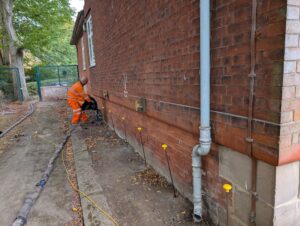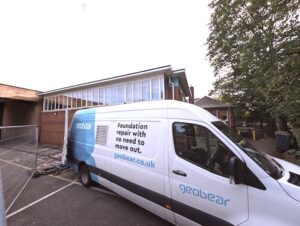Foundation Ground Improvement at Long Eaton Library
Geobear delivered ground improvement, an alternative to underpinning at the Grade II listed Long Eaton Library. Expansive geopolymer injections were used to stabilise the front-left corner of the building, halting subsidence and protecting this historic public facility without excavation or disruption.
 Background
Background
Long Eaton Library, a Grade II listed Carnegie library built in 1906, had developed settlement and cracking at its front-left corner. Cracks were visible externally in the brickwork and mullions and internally through plaster finishes.
A structural appraisal by HSP Consulting (2022) concluded that the movement was caused by shallow strip foundations set in high-plasticity clay, affected by tree root activity and rainwater discharge close to the walls. Left untreated, further settlement would have threatened both the structural integrity and the heritage fabric of this important community building.
A ground investigation (2023) confirmed the issue:
Foundations at just 0.44–0.54 m depth.
Upper clay layers classed as soft to firm, with SPT values of 2–4.
High shrink-swell potential due to moisture variation.
Dense sand and gravel stratum present below 2 m (suitable as a load-bearing layer).
The requirement was to stabilise the foundations, increase bearing capacity, and allow the corner of the building to be safely underpinned without excavation or vibration.
Key Stats
Location: Long Eaton, Nottinghamshire
Building: Grade II listed Carnegie library (constructed 1906)
Issue: Foundation movement at front-left corner due to shrinkable clay and water ingress
Scope: 25.8 m wall length treated (7.7 m front, 18.1 m side)
Injection design:
Injection points at 1 m centres
Three levels of treatment below foundation
Testing: Pre- and post-treatment Dynamic Probing (DPSH)
Outcome: Bearing capacity increased; settlement halted; heritage structure safeguarded
Challenges
The main challenge was stabilising a heritage-listed building in the centre of Long Eaton. Traditional underpinning or piling would have involved heavy excavation, vibration, and long-term closure of the library. This was not acceptable for a Grade II listed structure, particularly one with sensitive features such as mosaics, stained glass, and carved brickwork.
The soils posed further difficulties. The very soft clays beneath the shallow foundations had very low SPT values, meaning that any further drying from trees or wetting from downpipes could have caused accelerated movement. At the same time, the load-bearing sands and gravels sat deeper, so the solution needed to strengthen the upper soils while transferring loads into the denser layers.
The client therefore needed a precise, non-invasive solution that could be installed quickly and safely without damaging the fabric of the library or causing disruption to public services.
Geobear Solution

Injection methodology: Small-diameter holes were drilled through the foundation at 1 m centres. Steel tubes were installed, and expansive geopolymer resin was injected at three depths below the foundation level.
Mechanism: The resin expanded immediately on contact with the soils, compacting the clays, filling voids, and transferring load into the denser sand and gravel layer at depth.
Monitoring: Laser monitoring was used to detect any unwanted lift, ensuring that movement stayed within tolerances.
Verification: Pre- and post-treatment Dynamic Probing confirmed improvement in soil strength
The works were carried out entirely from the exterior of the building, avoiding the need for excavation or access restrictions.
Results / Carbon Effect
Settlement halted: The front-left corner of the library was stabilised, eliminating further structural risk.
Soil bearing capacity improved: SPT values confirmed a three-fold improvement, from very loose to medium dense ground.
Heritage safeguarded: The listed building’s historic fabric was preserved, with no invasive excavation or vibration.
Minimal disruption: Works completed with the library operational, ensuring continued community access.
Carbon savings: Compared to underpinning or piling, the geopolymer solution avoided large-scale excavation, spoil removal, and concrete use, cutting embodied CO₂ significantly.
 Background
Background